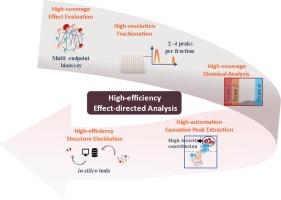当前位置:
X-MOL 学术
›
Environ. Int.
›
论文详情
Our official English website, www.x-mol.net, welcomes your feedback! (Note: you will need to create a separate account there.)
High-efficiency effect-directed analysis (EDA) advancing toxicant identification in aquatic environments: Latest progress and application status
Environment International ( IF 10.3 ) Pub Date : 2024-06-28 , DOI: 10.1016/j.envint.2024.108855 Wenrui Luo , Liben Chou , Qinglan Cui , Si Wei , Xiaowei Zhang , Jing Guo
Environment International ( IF 10.3 ) Pub Date : 2024-06-28 , DOI: 10.1016/j.envint.2024.108855 Wenrui Luo , Liben Chou , Qinglan Cui , Si Wei , Xiaowei Zhang , Jing Guo

|
Facing the great threats to ecosystems and human health posed by the continuous release of chemicals into aquatic environments, effect-directed analysis (EDA) has emerged as a powerful tool for identifying causative toxicants. However, traditional EDA shows problems of low-coverage, labor-intensive and low-efficiency. Currently, a number of high-efficiency techniques have been integrated into EDA to improve toxicant identification. In this review, the latest progress and current limitations of high-efficiency EDA, comprising high-coverage effect evaluation, high-resolution fractionation, high-coverage chemical analysis, high-automation causative peak extraction and high-efficiency structure elucidation, are summarized. Specifically, high-resolution fractionation, high-automation data processing algorithms and structure elucidation techniques have been well developed to enhance EDA. While high-coverage effect evaluation and chemical analysis should be further emphasized, especially omics tools and data-independent mass acquisition. For the application status in aquatic environments, high-efficiency EDA is widely applied in surface water and wastewater. Estrogenic, androgenic and aryl hydrocarbon receptor-mediated activities are the most concerning, with causative toxicants showing the typical structural features of steroids and benzenoids. A better understanding of the latest progress and application status of EDA would be beneficial to further advance in the field and greatly support aquatic environment monitoring.
中文翻译:

高效效应导向分析(EDA)推进水生环境中毒物识别:最新进展和应用现状
面对化学物质持续释放到水生环境中对生态系统和人类健康造成的巨大威胁,效果导向分析(EDA)已成为识别致病毒物的有力工具。然而传统的EDA存在覆盖率低、劳动强度大、效率低的问题。目前,许多高效技术已集成到 EDA 中以改进毒物识别。本文综述了高效EDA的最新进展和目前的局限性,包括高覆盖率效果评估、高分辨率分级、高覆盖率化学分析、高自动化原因峰提取和高效结构解析。具体来说,高分辨率分离、高自动化数据处理算法和结构解析技术已经得到很好的发展,以增强 EDA。同时应进一步强调高覆盖效果评估和化学分析,特别是组学工具和数据独立的质量采集。针对水环境中的应用现状,高效EDA在地表水和废水中得到广泛应用。雌激素、雄激素和芳烃受体介导的活性是最令人担忧的,致病毒物表现出类固醇和苯类化合物的典型结构特征。更好地了解EDA的最新进展和应用现状,有利于该领域的进一步发展,为水环境监测提供大力支持。
更新日期:2024-06-28
中文翻译:

高效效应导向分析(EDA)推进水生环境中毒物识别:最新进展和应用现状
面对化学物质持续释放到水生环境中对生态系统和人类健康造成的巨大威胁,效果导向分析(EDA)已成为识别致病毒物的有力工具。然而传统的EDA存在覆盖率低、劳动强度大、效率低的问题。目前,许多高效技术已集成到 EDA 中以改进毒物识别。本文综述了高效EDA的最新进展和目前的局限性,包括高覆盖率效果评估、高分辨率分级、高覆盖率化学分析、高自动化原因峰提取和高效结构解析。具体来说,高分辨率分离、高自动化数据处理算法和结构解析技术已经得到很好的发展,以增强 EDA。同时应进一步强调高覆盖效果评估和化学分析,特别是组学工具和数据独立的质量采集。针对水环境中的应用现状,高效EDA在地表水和废水中得到广泛应用。雌激素、雄激素和芳烃受体介导的活性是最令人担忧的,致病毒物表现出类固醇和苯类化合物的典型结构特征。更好地了解EDA的最新进展和应用现状,有利于该领域的进一步发展,为水环境监测提供大力支持。











































 京公网安备 11010802027423号
京公网安备 11010802027423号